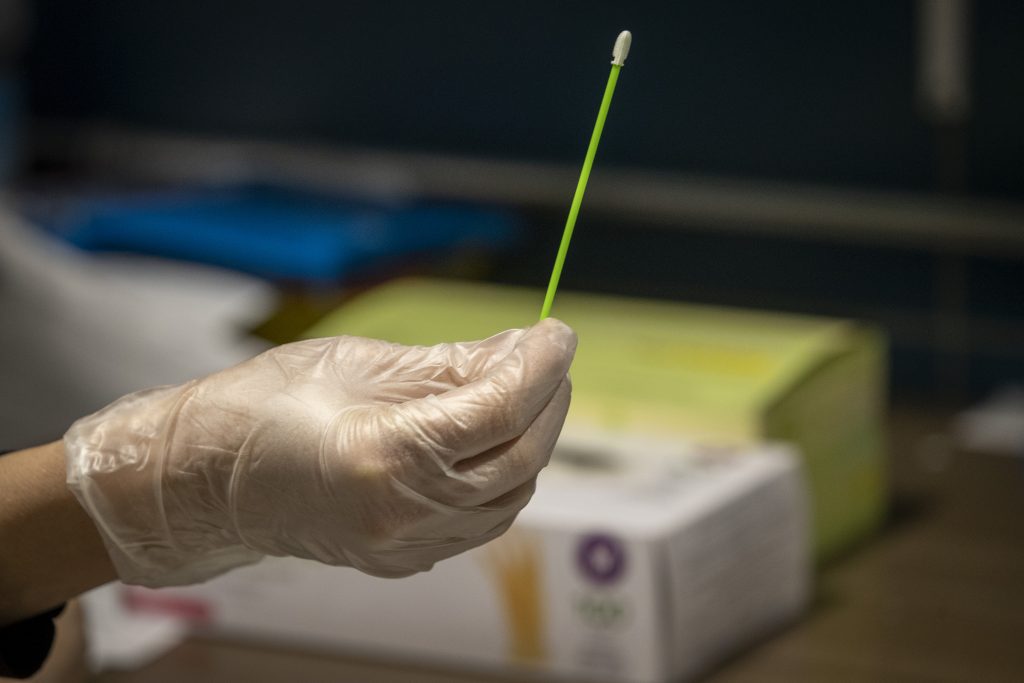Ontario cuts COVID isolation period in half for fully-vaccinated, updates testing guidelines

Posted December 30, 2021 5:53 am.
Last Updated December 30, 2021 9:02 pm.
The Ford government is updating Ontario’s COVID-19 testing and isolation guidelines in the face of the new fast-spreading Omicron variant.
Effective Friday, isolation periods are being reduced to five days for most fully vaccinated residents provided they no longer have symptoms of the virus and tests are being saved for the most vulnerable residents.
The move is in consultation with the province’s chief medical officer, Dr. Kieran Moore who made the announcement on Thursday during his weekly COVID-19 briefing. The changes are being made in an effort to better protect vulnerable residents and ensure tests are available for the highest-risk settings.
“Focusing our testing and case and contact management on high-risk settings will help limit transmission, maintain critical workforces, and ensure timely access to PCR testing where it is needed the most,” said Moore. “Anyone who is sick should protect their community by staying home.”
As of Friday, Dec. 31, the province is altering its isolation guidelines based on evidence that “generally healthy people with COVID-19 are most infectious in the two days before and three days after symptoms develop.”
People who are fully vaccinated and children under 12 will now only be required to self-isolate for five days following the onset of symptoms. If symptoms are improved within 24 hours of the end of the five day period then they can end their isolation.
Household contacts are still being advised to isolate with individuals who tested positive and non-household contacts should self-monitor for symptoms for 10 days.
Ontarians who are unvaccinated, partially vaccinated or immunocompromised and test positive are still required to self-isolate for 10 days.
Health care workers who work in high-risk settings are being asked to return to work after 10 days from their last exposure, symptom onset, or date of diagnosis. These workers will also have the opportunity to return to work after seven days with a negative PCR or rapid test that will be provided to health care settings by the Ford government.
The province is also changing its testing guidelines and publicly-funded PCR tests will only be available for high-risk residents who are symptomatic or are at risk of severe illness (see full list below).
Anyone else who is not considered vulnerable and is experiencing mild symptoms of the virus are being asked to not seek testing. Non-vulnerable individuals who test positive using a rapid antigen test will no longer be required to get confirmation via a PCR or molecular test.
Eligible Groups for PCR Testing:
- Symptomatic people who fall into one of the following groups:
- Hospitalized patients
- Patients in Emergency Departments, at the discretion of the treating clinician
- Patient-facing health care workers
- Staff, residents, essential care providers, and visitors in hospitals and congregate living settings, including long-term care, retirement homes, First Nation elder care lodges, group homes, shelters, hospices, temporary foreign worker settings, and correctional institutions
- Outpatients for whom COVID-19 treatment is being considered
- Underhoused or homeless
- People who are from First Nation, Inuit, and Métis communities and individuals travelling into these communities for work
- Symptomatic elementary and secondary students and education staff who have received a PCR self-collection kit through their school
- People on admission/transfer to or from hospital or congregate living setting
- High-risk contacts and asymptomatic/symptomatic people in the context of confirmed or suspected outbreaks in high-risk settings, including hospitals, long-term care, retirement homes, other congregate living settings and institutions, and other settings as directed by the local public health unit
- Individuals, and one accompanying caregiver, with written prior approval for out-of-country medical services from the General Manager, OHIP
- Asymptomatic testing in hospital, long-term care, retirement homes and other congregate living settings and Institutions as per provincial guidance and/or Directives
RELATED:
-
Study – Omicron risk of hospitalization, death is 54% lower than Delta
-
Ontario opposition leaders call for clarity on back-to-school plan amid Omicron spread
-
New COVID-19 health measures announced amid another record-breaking day in Canada
The Retail Council of Canada applauded the Ford government’s decision to shorten the isolation period saying labour shortages have dogged retailers throughout the pandemic but the recent sharp rise in infections has left many scrambling to adjust schedules and keep their doors open.
Michelle Wasylyshen, the industry group’s national spokeswoman, says allowing employees to return to work sooner after they recover will ensure adequate staffing to maintain health and safety standards like frequent cleaning and enforcing mask mandates and capacity restrictions.
Opposition NDP Leader Andrea Horwath released a statement urging Doug Ford to “immediately reverse” the decision to restrict testing for the majority of residents.
“We need to ramp up to make testing more available, not cut people off,” said Horwath in a statement. “Telling people to simply stay home instead of getting a test is shockingly cruel when Ford won’t give people adequate paid sick days.”
Moore hinted last week that Ontario was preparing to change its preemptive approach to testing and contact tracing as the Omicron variant strains resources, with residents being warned they could face long waits for tests.
The U.S. Centers for Disease Control and Prevention (CDC) cut isolation restrictions for Americans who catch the virus from 10 to five days and similarly shortened the time that close contacts need to quarantine.
CDC officials said the guidance is in keeping with increasing evidence that people with COVID-19 are most infectious in the two days before and three days after symptoms develop.
Moore also announced Ontario is pushing back the return to in-person learning until Jan. 5 in order to provide more time to implement additional health and safety measures. Classes were originally set to resume on Monday.
The province set yet another record for confirmed daily COVID-19 cases on Thursday, recording 13,807 new infections and a 30.5 per cent positivity rate. Hospitalizations are also up with 965 patients admitted in the last 24 hours.
Moore’s announcement comes on the heels of the latest data courtesy of Public Health Ontario, which suggests the Omicron COVID-19 variant causes less severe illness.
The study compared Omicron cases against Delta infections and found the risk of hospitalization or death was 54 per cent lower with Omicron.
But experts say the sheer number of people becoming infected — and therefore having to isolate or quarantine — threatens to crush the ability of hospitals, airlines and other businesses to stay open.
With files from The Canadian Press








